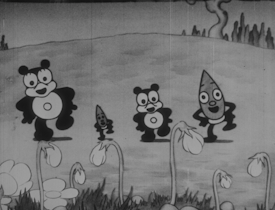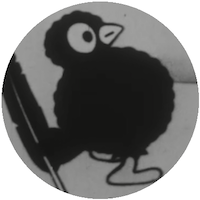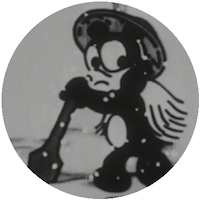Spring Comes to Ponsuke
| Original Title | ポン助の春 |
|---|---|
| Japanese kana Rendering | Ponsuke no haru |
| English Title | Spring Comes to Ponsuke |
| Production Date | 1934 |
| Author | Ikuo Oishi |
| Duration (minutes) | 7 |
| Sound | sound |
| Color | b/w |
| Plot | Ponsuke, a child raccoon wearing a straw raincoat and a hat, is digging up bamboo shoots in a forest covered with snow. Father and son crows, perched on a tree branch, laugh at Ponsuke buried under a snow block that fell from above. Angry Ponsuke aims a shotgun at the crows, who fly away. When Ponsuke shoots the gun, the son crow comes falling down. Ponsuke plans to pluck the crow and take it home to please his father. However, when he plucks the bird, he finds out it is skinny and wearing only a loincloth. Disappointed, Ponsuke tosses him away. The crow sneezes and comes back to life; he puts on the plucked feathers like a coat and leaves marching to the tune of a military march. Then, a snow block comes falling and causes Ponsuke to snap out of the stupor. Digging in the snow, Ponsuke finally finds a large bamboo shoot. Seeing Ponsuke taking the bamboo shoot with great pleasure, the bamboos in the forest shed tears of grief. It is winter, when there is little food. The mouse in the raccoon house is also skin and bone. Ponsuke comes home with the large bamboo shoot. The father raccoon, who has been waiting for Ponsuke, embraces him with joy. When the father and son strip the bamboo shoot, only a very small core remains. The bamboo sheaths regrow into a large bamboo shoot and it runs out into a blizzard with the little bamboo shoot. Snow blowing into the house turns the raccoons into snowballs. The snowball raccoons chase after the running bamboo shoots. As they continue to run, the season changes from winter to spring. As spring flowers come into full bloom and everyone gets tired from running, the snowman melts. Bees bring a jug of honey to the raccoons and the bamboo shoots. Satisfied with the honey, the raccoons shake hands with the bamboo shoots to make peace. The bees and the flowers sing and dance to the tune Spring Has Come and the raccoons and the bamboo shoots join in the dance with joy. In the end, Ponsuke takes off his silk hat and extends farewell greetings to the standard Cuban song The Peanut Vendor. |
| Description | This is the second animation released after Battle between Foxes and Raccoons (1933), which Ikuo Oishi directed as the manager of Photo Chemical Laboratory, Manga Division. Ponsuke and his raccoon father appear in this movie, as in Battle between Foxes and Raccoons. As in the previous film, Ponsuke behaves as a rascal in this film. The opening title, credits and the end mark are missing from the existing print. However, according to the Home Ministry's Movie Censorship Report, the film was 206 m in length and lasted for 8 minutes. This leads us to believe that the main part of the film is almost all intact. The third P.C.L. animation produced after this film was Kachikachiyama (1934). All three of these animations feature raccoons as the main characters. After World War II, Ponsuke Competes with a Rabbit (1951) was produced by Toho Educational Movie Company. This movie was adapted from Kachikachiyama and re-edited by Toshiro Wakabayashi, Oishi's apprentice. Online release of a talkie film requires obtaining the permission to use copyrighted music in the film. To that end, it is necessary to identify the titles of individual tunes. This film was publicly released thanks to the efforts of the music critic Masato Mori, whose research enabled us to identify the titles of all tunes used in this film (Yukiya Konko, Military March composed by Schubert, Toy March, Kutsu ga Naru, Spring Has Come and The Peanut Vendor composed by Moises Simons) and to confirm them to be in the public domain. While accompaniment music arranged from traditional Japanese music (by Koichi Sugii) was used in the previous animation Battle between Foxes and Raccoons, children's songs and other tunes used in this animation are arranged in a jazz style. The music is thought to be performed by the P.C.L. Orchestra managed by Kyosuke Kami. |
| Production Company | Photo Chemical Laboratory, Manga Division* |
| Distribution | Towa Shoji Eiga Division* |
| Release Date | Jun 29, 1934 |
| Credits: Director | Ikuo Oishi* |
| Credits: Staff, Cast, etc. | |
| Intertitles | |
| Censorship - Date and Number | [Note] Home Ministry censorship number: I9591 (August 1, 1934) |
| References | |
| Frames per Second | 24fps |
| Source of Digital Copy | (Picture)The 16mm positive owned by Planet Film Archive -> The 35mm internegative owned by NFC (Sound)The 16mm positive owned by Planet Film Archive -> The 35mm original sound negative owned by NFC -> 35mm positive |
| Completeness | no main title no credit titles the former part is missing no end title |
| Additional Notes | The mark of "*" will provide an additional explanation gained from the bibliographical information. |
| Related Links |
Related categrory
- Musical
- Run & Walk
- Eat & Drink
- Dance & Sing
- Cel
- Bird, Pheasant, Duck
- Raccoon dog
- Goblin, Plant, Others
Main characters
Please tell us what you think about this website by filling out a short questionnaire.
To educational users: Please provide us with feedback on website usage for educational purposes.
- Unauthorized copying and replication of the contents on this site are prohibited.



